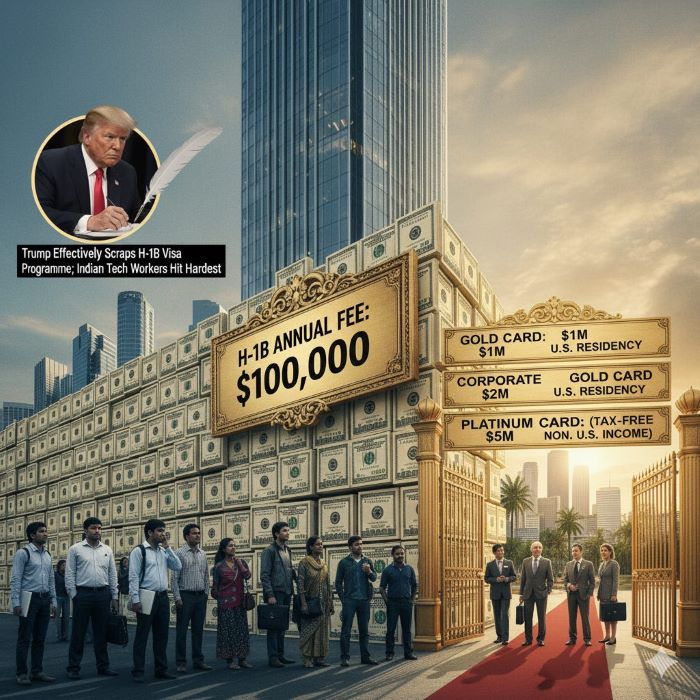 In a sweeping move late Friday, President Donald Trump signed an executive order imposing a $100,000 annual fee on successful H-1B applicants — payable each year for up to six years. Marketed as a push to attract only the genuinely “high-value” foreign talent, the measure transforms the economics of hiring under America’s most popular skilled-worker route and, in practice, closes the door on entry-level and mid-career professionals who have long relied on employer sponsorship.
In a sweeping move late Friday, President Donald Trump signed an executive order imposing a $100,000 annual fee on successful H-1B applicants — payable each year for up to six years. Marketed as a push to attract only the genuinely “high-value” foreign talent, the measure transforms the economics of hiring under America’s most popular skilled-worker route and, in practice, closes the door on entry-level and mid-career professionals who have long relied on employer sponsorship.
Silicon Valley’s Longstanding Pipeline, Upended
The H-1B visa has long been the backbone of Silicon Valley’s global talent pipeline. Roughly 85,000 new visas are issued each year through a lottery, and about half a million workers currently live and work in the United States on H-1B status, renewing every three years. Traditionally, the programme offered a pathway — slow but tangible — towards a green card and eventual citizenship. That balance has now shifted dramatically: employers must weigh salary plus $100,000 per year in government fees before deciding to retain or sponsor a worker.
Who Gets Hit First — and Hardest
The hardest hit will undoubtedly be Indian tech professionals, who account for over 70 per cent of new H-1B visas, followed by Chinese nationals at around 12 per cent. For aspirants earning in the $100,000–$150,000 range, the new levy renders sponsorship uneconomical unless the role is clearly “mission-critical”. Employers are expected to restrict sponsorship to only the most specialised engineers, researchers and senior executives, whose compensation package is big enough to absorb the hefty annual fee..
“Gold” and “Platinum” Pathways for the Wealthy
Alongside the H-1B clampdown, the order introduces a $1 million “gold card” for wealthy individuals seeking U.S. residency and a $2 million “corporate gold card” allowing companies to sponsor one or more employees. A “platinum card”, priced at $5 million and permitting up to 270 days’ residence per year without taxation on non-U.S. income, has been flagged as “coming soon” — though it will require congressional approval. The message is clear: while the door for skilled workers is narrowing, the gates for wealth are being thrown wide open.
Universities: A Narrow Carve-Out
There are signs of a small carve-out for universities, particularly in the recruitment of professors in STEM fields. However, this exception is unlikely to alter materially the fortunes of current H-1B holders or the prospects of future aspirants in the private sector.

The Legal Storm to Come
This order is almost certain to trigger immediate legal challenges. Critics point out that while the executive can set enforcement priorities, it is Congress that holds authority over visa categories and fee structures. Courts will be asked to determine whether the White House can lawfully impose a six-figure annual fee and create new visa classes without legislation. Injunctions may delay the rollout, but employers cannot rely on indefinite uncertainty. However, given the recent trend — where far more contentious and even questionable orders on issues such as “citizenship by birth” and trade tariffs have been issued — the courts have generally refrained from granting blanket stay orders. Therefore, in our opinion, no imminent relief through legal channels is likely.
Silence in Silicon Valley
Unlike earlier immigration battles, most tech giants have so far remained remarkably silent — offering only brief statements that they are “reviewing the implications”. The arithmetic is stark: sponsoring a single H-1B worker for six years could now cost a company $600,000 in additional payments to the government, on top of salaries and legal expenses. Unsurprisingly, firms are already modelling offshore relocations and shifts towards local hiring, even where domestic talent is scarce.
Not So Fast: The HIRE Bill and Software Tariffs Close the Escape Hatch
A newly introduced HIRE Bill would slap a 25% tax on payments to overseas workers and even deny tax deductions for those outlays—an explicit bid to make offshoring uneconomic. Add to that fresh talk of tariffs that could extend to software/digital services, and the once-obvious workaround—relocating small teams abroad—may prove costly or short-lived, especially if future U.S. actions tighten the net again.
What It Means for Current H-1Bs
For current visa holders, the main question is whether the new levy applies immediately or only at the time of renewal. If it applies upon renewal, employers will soon face the choice of paying the steep fee or winding down roles. Workers are anxiously awaiting clarification in official guidance, while lawyers prepare to challenge the measure in court.
The Fiscal and Political Pitch
The Trump Administration is presenting the move as a way to reduce taxes and shrink the deficit, framing the levy as a patriotic contribution by foreign workers. At its core, the rhetoric leans heavily on the long-standing campaign promise of “jobs for Americans first” — the idea that every H-1B role should, wherever possible, be filled by a U.S. citizen. Officials argue that the new fee forces companies to think twice before “outsourcing through visas,” ensuring that only the most indispensable foreign specialists are brought in.
Critics, however, counter that many of the roles filled by H-1B holders cannot be easily replaced by American workers. They warn that imposing a $100,000 annual surcharge will not automatically translate into domestic hiring but will more likely drive employers to export jobs abroad, moving operations offshore rather than repatriating them. In this reading, the measure risks weakening America’s competitive edge rather than strengthening it.
The Tax Angle — Green Cards Versus New Pathways
Under U.S. income tax laws, green card holders are liable to report their worldwide income once it exceeds $10,000 annually, even as they retain their original nationality. Such income is subject to U.S. taxation, with only narrow relief available under the respective bilateral Double Taxation Avoidance Agreements (DTAAs). In recent years, this has led some green card holders to forego renewals, choosing instead to travel to the U.S. occasionally on B1-B2 visas to avoid cumbersome reporting obligations, and income tax liabilities and penalties.
By contrast, Trump’s new “gold” and “platinum” visas create wealth-based residency channels with fewer strings attached — even exempting non-U.S. income from taxation under the platinum tier. The contrast could not be starker: while highly skilled workers face prohibitive costs, the wealthy are being courted with privileged pathways.
India’s Stake — and a Strategic Reframe
India has been the chief beneficiary of the H-1B programme, and the shockwaves will be felt across Bengaluru, Hyderabad and Gurgaon. In the short term, there may be fewer U.S. placements, greater reliance on offshore work, and shifts in remittance flows. Yet India’s technology sector is now more mature than ever, with world-class capacity in cloud, AI, silicon design and product-led startups. The potential opportunity lies in retaining and repatriating talent.
We See Opportunity in Threat
Although this is a sovereign decision of the Trump 2.0 Administration, the timing — during a lean patch in India-U.S. relations — will inevitably fuel criticism at home. Opposition voices may allege that Prime Minister Modi’s inept handling of foreign policy has invited Washington’s wrath. Yet it is also true that “sweet are the uses of adversity”. Rather than bemoan a closed pathway, India must seize the moment to create an eco-culture of startups, retain its brightest minds, and build a bigger and better version of Silicon Valley on Indian soil, tentatively branded as ‘BharatGhati’.